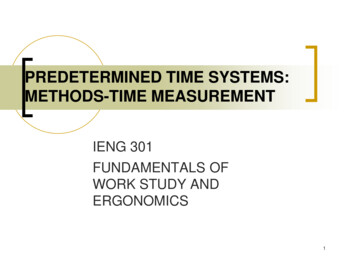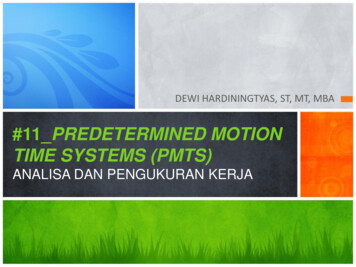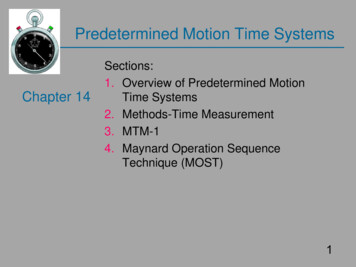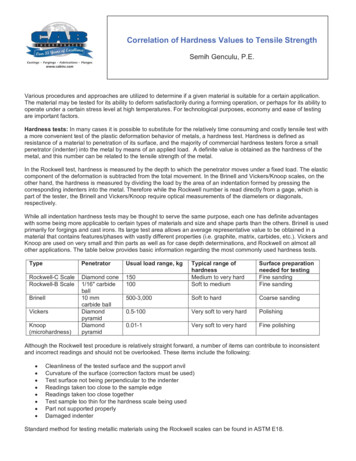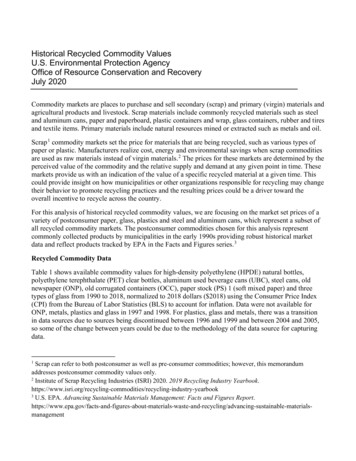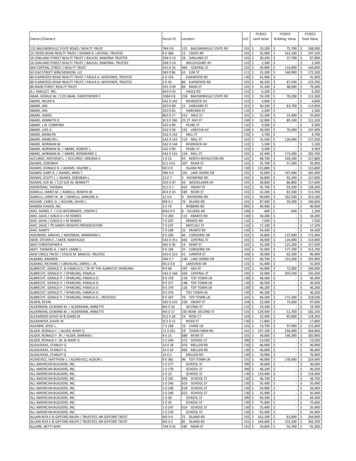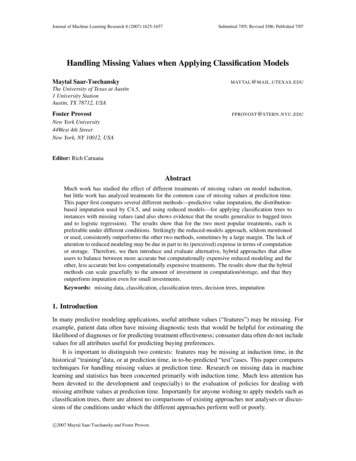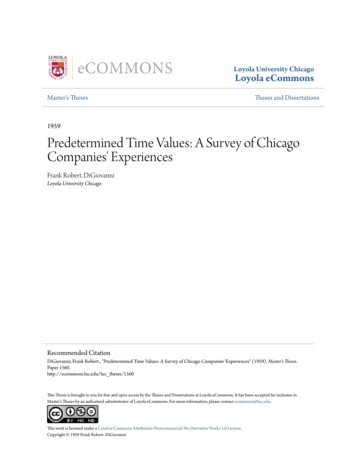
Transcription
Loyola University ChicagoLoyola eCommonsMaster's ThesesTheses and Dissertations1959Predetermined Time Values: A Survey of ChicagoCompanies' ExperiencesFrank Robert. DiGiovanniLoyola University ChicagoRecommended CitationDiGiovanni, Frank Robert., "Predetermined Time Values: A Survey of Chicago Companies' Experiences" (1959). Master's Theses.Paper 1560.http://ecommons.luc.edu/luc theses/1560This Thesis is brought to you for free and open access by the Theses and Dissertations at Loyola eCommons. It has been accepted for inclusion inMaster's Theses by an authorized administrator of Loyola eCommons. For more information, please contact ecommons@luc.edu.This work is licensed under a Creative Commons Attribution-Noncommercial-No Derivative Works 3.0 License.Copyright 1959 Frank Robert. DiGiovanni
PREDETEi{[ ':INE DTI1-A:fJ; V il LUES :J SU RVEY OFCHICAGO CONa'ilNIBS t &XPERIifNCESbyFrsnk: Robert DiGioVB,n:ni.A Thesis Submitted to theFacuity of the Greduete Schoo1of Lo7Qls University in PGrtis1 Fulfillment ofthe Requirements for the Degree of Masterof 80ci81 and Industrial ReletionsJune1959
illChapterIV.PageCONCLUL IONBIBIIOGRlIPHY 11 PPE!lJD IX I 66 70 . . . . . . . . . . . . . 74APPENDIX II . . · · · · . · ., . . . . . . . 75APPBDIX III (Information about Work-Factor).-." ,J
Ct.:. APTF;RIINTRODUCTIONA.Nature ! !h!problem:rfhe American J!rbitrE;tioll .As;;;ociation hes iIlvesti6atedthe grievances over production stendLxds thct requiredarbitration in 1954.The results of this stud3 indicatethat of their sample of 1728 tots1 cases that went toarbitration, one hundx'ed seven (6 per cent) weI'S concernedwith incent ive plans.:fwo hundred twenty-three additions Icases (1.3 per cent) were concerned with dob evaluation.l·owever, "meny of these disputes on teAe surfece seemed tobe job eveluation questions while in tact they were disouisedrequests tor individual wageincentive rates."lincre. sesor ad.justments ofThis seems to indicate that incentiveplens were actuall.V responsible for en agt;,regBt6 19 percent of the eases in teir sen.ple that were et'bitrated in1954.Some labor leaders favor production stande::rds es er!le8n lAmerican Arbitration Association Procedural end. Substantive sR!cts of ti'6or-MaIlatSKent ftrbltretion, mAn-Research Heport, !V8sLJ:ngton, (57), 23-30.1
2ofceesuring operator efiiciency.'l'bis o[)viEtes the possibil-ity of supervisors dischcr6ing indiscrimina te 13 on the cesisof inefficien.cy.:4:be president of a 161:6e Chic060 lac, 1 of'the lilectricel Workers eXf;ressed it in this r:l6nlleI:Utf'heeLpl01er is entitled to e fe ix-de;}' t s wo:rk, but 'the unionshould see that the HorKer receives a feir-u6J'sreturn. ,inHow they LemployerEf] arrive at the standerd isthe comfiany's prerogative as longbSthe worker doesntthave to break his beck to meet it. M2"Union 0!11eisls ere A recent research study found:unanimous in their insistence thet time stbncl.ards and w()rkloeds be determined bilaterally, either throu6b. joint union-management participation in the initial settinG of stendardproduction rates or through the grievance, negotlation end7.arbitration of ch8lltSes in rates set b.y mGne6ement.It.lDr.Gomber5 (formerly 6 union s},okesJIfsn) fee Is thbt uIlion SilOUld"psrticip8 te in rEteBEl'ttinb because thetLi:8 .study teefllliquesin use today are unscieuti1ic. 42Intormatioll from a phone interview of the aut.hor withike Frank Darling. President rloesl 1031, InternationalBrotherhood o!B;iectricbl ';/orkers, July 2b, 1958.3C11fford M. Baumbach, "Incentive Wage PrOblems in Collective Bsrgaining,It, Research Series, 14 (State UniverSity oflows, Iowa City, 1956), p. 3.4W1l11am Gomberg, .A Trade Union .An81 Sis of Time Stuuy,Science Research Associetes, ah1c go, l .-- ----
3The evidence presented 6ives the reader au indication oftbe nature of the problems resulting trom the setting otproduction standards.B.The three aspects .2 ,w8se determination:Contrary to the belief in some circles,· work measurementis not the sole determinant of weges.In a rneakiured-d.ay-worktype of operation, for exam,1 le, work measurement is not thedeterminant ot wages.This type ofo erationuses work mea-surement to determine the output f'or specific operations, insetting production schedules.However, the determined pro-duction standard should reflect a "normal .\forking poce", sincean acceleroted (tie,ht) standard. woulci not be consider'ed fs ir tand would undoubtedly brine! oomplaints from the workers andtheir representatives.In practice, wagesin thistYf;eot. operation are. ietermined by a combination of work me66ure.-ment and job evaluation.Whereas t "the incentive tJ'.i:1 3 'operst-ions heve an additional aspect, incentive opportunity.There ere four commonly used methods of work measurement (the fixst aspect of wage determine tion).method is "measurement by estimates".'11he .firstUnder this method,the foreman is responsible for determining the.SCOjJSottbe work as well as estiniating the perfornu;"llce tin:e based on·This idea is common amoniSengineering and union people.Bler68 number 01 n:en 't:!) nent,
4-his own personal judgment.The second method to arrive at Bst&nderd is "measurement by historicsl records".This methodarrives at a standsrd "by comparin!6 actual man-hours required011any job with a standard index baseo. on average historiCf.lltime for that type of work.,,5The refinement of production methods necessit.ated a refinement inthe method of arriving at the iJroductionsta d erds.' In the early stages of the industrial revolution thedesigners did not Nork with ver'] close tolerances.It wasconsidered a Ureal accomplishment when they [deSigners]tiDally manufacturedof an old shil11ng. 1t6857" cylinder, true Hithin the tbick.nessSubsequently, stander'ds besed onestimation or historicsl records Ivers not compet1bl( with tnedegree oi.refinement found in the more advanced type of kJroduet ton runs, since the inet.fic1encies that existed in theperformance record or the mind 01 bef'oreman would heve beenperpetuated tnroughout,the entire operation.Frederick Winslow TaylClx, tbe father 01 modern scientificl11Sn ;ement stop watchniques.8Sis generally credited with introducin6 thea means of refining tL:estandard-settin tech-This led to the third method of work measurement, the5JOhn 0 Heritage, "iflork Meesurement in Maintenance n,F'ector:t Man8 ement Maintenence, eXITI (January 1955) t 89-90.6 n W Karger, "Background of Predetermined Time Systeu;s" JTethods!!!!l!Measurement Journal, III 2 Olay-June 1950).t
5This metboa requires the analystdirect time study method.to determine, with a stop Nstch, the time required to performs complete oper::tion.IrhlSprocess is repeated for e number ofcomplete cyclles; all the observetions Bre averaged out andthis figure 1s reduced to8unormsl time" by8ret1ng process."Rating 1s tbe pxoeess during Nhict: the time study mencon: 'peresthe perfor::::H3nce. . of theoperator under observc-tion with .the observer I a Qi.'in concept 01. normsl parforlr,().t1ce. II?Tbe direct time study method has been .criticized beceusethisr:::ting factor is str1c·tly in the· mind of the observer.Ob-vioualy, the retinl:!, .i:Jroce86 is. subJective Slid it ma;)' well beth t it will ceuse inconsistencies in the rete settiug precess.These inconsistencies mey adversely effect; employee morale.The fourth method of Nork measurement is the standarddata method. job'This· :metnod requires the tfbreCiking down of ainto its besic component parts.".'The component parts ofall jobs are compared and t')xouped so that the same time' isallowed for the semeelement each time it occurs. 8,Whereas work measuremen.t is BmanBgel:;ent teChnique ·toat tempt to arrive at e fa 1r-da;y' S lfork., en at tempt to determinea fair-dey's Jl!Z·uses the second aspect of W868 determination,7H8lp b. M. Bernes, IJotion a.ncl Time : tUd.3, jrd edt (NewYork, 1952), p. 352.8aeritage, p. 91.
"il he Jusin pux'pose 01 job evc;luotion il;;i tojob evaluation.furnish to mallc6ement ana to the employeesBandsy ,tewBticfsctusl bssis for the classification 01 positions and fortable wage BudSCie ui-lc:ry payments on the besis 01 the kind, inJioI.'tsnce alld difficulty of the jobs."evaluation, therefore, to arrivejobs in the org(;nizetion.It is the 00J6ccive of job tthe relativev& ueof t(I'nis relationship is established byevaluating the job requirements in arees such as education andexperience; responsibility; mentel Bnd visual application;dexterity end eccurEcy. physical exertioll tBAtt wor in6Qconditions./InBmeasured-dey-work type 01oper tionit isa arentthat work measurement is not considered to be s.ynonolilous withWB8e determination, since tbe production stf,Ild .;rd does notdetermine th.e wBe! es oftbe WOrliElr.I tllis tj',t; 01 operationthe 'pace of the work-flow 1s usually rr.Gnt:g.ement cont;t'Glled.Th.e basic function of NOrkto determine this pace.iUHi UreLlle!ltin these inst6,uces isThe fc:ilu.Ie of the lliorkar to meet thispace may result in tranBfe.t or ultimately in discharBe.Incentive ty'pe operations use the third GiS./:'8ct 01 JU:36Eldetermination, finelJ.cicl iJ.lcentives.:I'be purpOSE! of theseincentives is to offer to the WOIAers tne opportullit;y to in-9J L Jacobs, "J·ob EVBluction", Motion-'l'ilne-Anslelsi;;.;Bulletin, XX (Januery Bud MBrch 19 ).A
7creese their earnings by increesin6 their roductivity.increased productivity is eccomplioh d byperformi.n tion atallaccelerated pace tcndfollows the motion pettern whichno time is lost.Thisthe opers-in aduitioll. tue NOr.lterhs been"This incr'eased. effortout so thet.ork dC H.1only be eX.i!encted.appreciably if no skill is required to jieriOrl'H tbeoperatiou"lOThe importallce of a soundsystem of workan incentive operction is quite apparent.eesurement in:B'or exar;'plet"loosestandards" would result in additionsl remuneration with littleincrease in effort.Conversely, "tight stBudards tl would de-priya the worker of the dditional compensation, to which heis entitled, for the additional effort thet he exerted to meettbe standard.Where standards have been set inaccurately, byestimation, historical records or airect time study, rbtecutting""'by msnscement ms,)' result.' Consequently, it is. notunususl for the worker to lim1.t his production onBloose-r8tedjob to prevent such ffiCinsgelIlent action.In many cases employing an incentive sYlOtelll t it has beenfound that workers and their representatives tend to identifytheirwB 5eswith the J:lroduction st8nd rd. 'hisidenti.ticBtionseEms to exist most often in those instances Where job evslust-lOIllformation from. a personal interview of the Guthor withOwen Fa1rweather, Seyforth, Shaw, Fairweather &. Geraldt;;on tPttorneys at IJaw. July 21, 195e"
8tion has established such8low' base rate that the opere tor isnot required to exert much effort to meet it. llrete violates the basicprinci lesof8This low baseeounti incentive yotem.nBmely:The basic wege should reflect the rel6tlveworth of the job in the company; wOlk messurement should determine the time required to perform the operstion. at B nOIwal sce Bud incentive opportunity should. be Offered for increasedeffort only. Therefore, incentive operations enumeasured-dey-work operations aifier in so fBr ssextra effOi for adoitional eaI!J.i1l6s alone ereconcerned.c.History.2! predetermined values:Frederick Ta.]lor was aware of the inherent shortcomingsJof the direct time study method, for rate settinB purposes.He envisioned the p08sibility of catalo3ued tables for ce.rtsi.umotions based on years of stop watch dste.However, the de-velopment ot tbe problem is credited to :I'a,llor' s contemporeriesFrenk B. end Lillian M. Gilbreth.'The Gilbretns concentrt·ted the ir efforts in the eree ofmotiOllstu 1I.;rhey developed 8 set of fundsmeatal motionswhich they celled therbligs C}ilbre th spe lled backwards).Itwssntt long before it was realized th t 1.ihere were fewllInformation frow a personal interview of tue suthorwith Edwin Housch, Director of Inuustr'ial Helatiolls, Rober'tNieminen, MeD.sd,ier of rllenu.facturing Service S SJ.1d Willian llde,;.;BI1sger of Industrial Engineerine;, Kellogg L1witchboard alldSupply Co., April 1, 1958.12 Ibid -
9differences between the Ta;ylor and '}llbreth approach.These'Here reconciled, and th.ey .vera combined in wtat is no\'1 kncJJl1.as methoq.s enj;!,ineerinl,;.13The Gilbreth 8pproschreconciliation.school. NGSnot dL::cerded bec:.:use of thisIt actually developed into the oicromotion"Micromotion is thestu yof thefDnda entBlelements or subdivisions of ar:. operi:tion by .maeus of e lllotion-picture camera and s t1ming device which eccuretelJ indic8t st;,e time inter'vDls on the motion-picture film . "14Thismicromotion school has developed fundamental tf:bles 01 ,vr determined time values.The advocstes ot. tnls ap'proach con-tend that this method minimizes the ere a of human JudgrnentcOllBiderebly."/hether the production standard is epplied to e measured-day-work oper;::; ion or to an incentive Of era tion, predeterrr:inedtime values must include certsinB 110weDce 11ow8nces.The fir tto be considered should be for pex SOlle31 tilDetisti8ue and unavoidable delays.Tillie must be allowed lor thepersonsl needs of the employee.'l'his may be allowed by grant-ing organizedr stperiods, or it may be allowed by loosen-ing.the production stand[rd proportionately.Fatigue, aD abstract term, is assumed to be the cause for--13Ksrgel''f Methods Time Measurement Journal.14Bernes, p.15.
10decreased productivity durin5 the "lest hours of tIle us;'!",although no conclusive evidence exists tl:et other fectors maynot be 'psrtially responBible.T!:isallovH nceInc:! be ep'plicdby loosening the st,.;ndaxd thereby incree siui! thetot 1 tirH allowedfo oper tion.theUnevoid6ble deley elloNsnces totake care ot downtime and. other CEuses beyona the operrtor'scontrol are ap
direct time study method. This metboa requires the analyst to determine, with a stop Nstch, the time required to perform s complete oper::tion. IrhlS process is repeated for e number of complete cyclles; all the observetions Bre averaged out and this figure 1s reduced to 8 unormsl time" by 8 ret1ng process.
